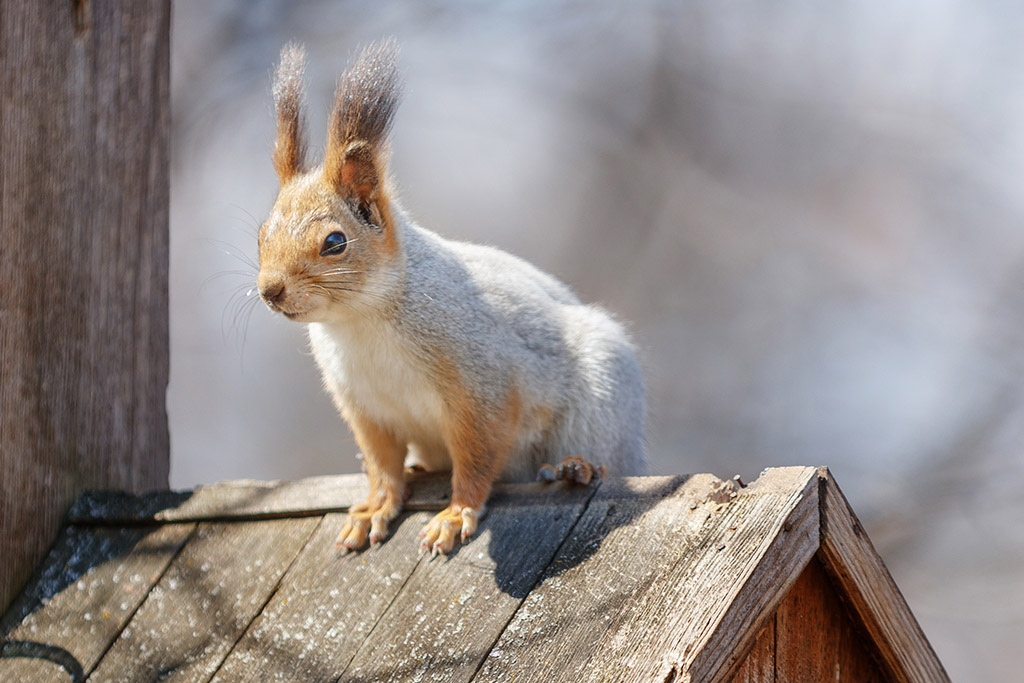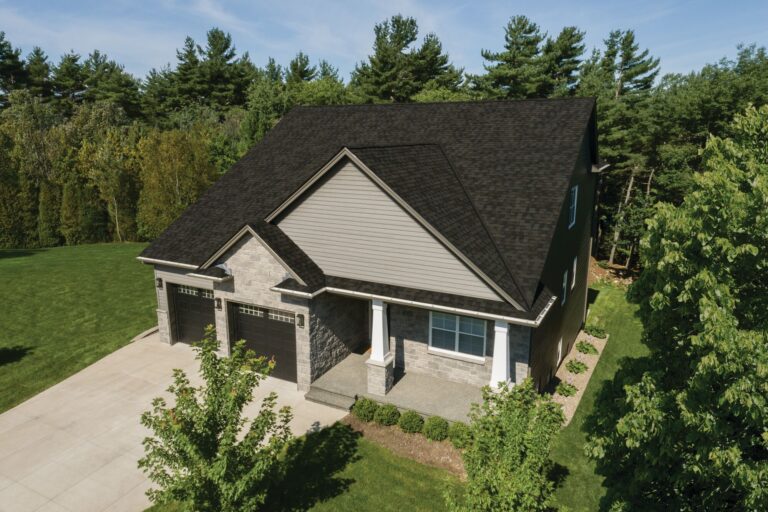Are You Dealing with Animals in Roof Vents and Attics?
IKO has helpful information and tips to get them out and keep them out
North America is home to a wide variety of wildlife. We’ve all heard the expression “bats in the belfry” but what about squirrels in the attic, raccoons on the roof, birds in exhaust vents and other critters you’d prefer to see in nature, not in your home?
In this article, we’ll answer these questions for you:
- How do I know if I have uninvited animal guests?
- How do animals get in the attic?
- What kinds of animals get in the attic and what potential damage can they cause?
- How can I prevent animal problems?
- What are some ways to get rid of animals in the attic once they’re there?
- Does my home insurance cover wildlife incidents?
- What does it cost to have animals removed?
1. How Do I Know if I Have Uninvited Animal Guests?
Animals are most likely to break in and enter your home in spring, when it’s mating season and they need a cozy place to nest and in fall, especially in northern climes where they seek warm shelter from the coming cold of winter.
These uninvited, unwelcome visitors may announce their presence by sight, sound or smell. If you hear animals on your roof, notice animal droppings on your roof or actually see critters moving under the eaves or physically entering your home, first walk around your house and check things out from ground level.
2. How Do Animals Get in the Attic?
Look for these telltale signs of entry:
- Missing shingles.
- Holes in the soffits or siding.
- Loose fascia boards.
- Unscreened, open gable or ridge vents.
- Open or uncapped chimneys.
- Gaps between the fascia and the eaves.
Inside the home, examine your attic. Look, listen and sniff for these signs:
- Ripped insulation or air ducts.
- Gnawed wires or PVC pipes.
- Nests or hives. (These may also appear on the exterior.)
- Urine or droppings.
- Unusual sounds overhead or inside walls, day or night.
Squirrels are most active during the daytime; nocturnal animals in the attic include racoons and bats. The footfalls of squirrels, rats and mice are light and scurrying but those of raccoons are slow and heavy. Some animals vocalize; others are silent. You may hear noises overhead in the attic, on the roof or inside chimneys, walls, ducting or exhaust vents.
3. What Kinds of Animals Get in the Attic and What Potential Damage Can They Cause?
Some homeowners experience infestations of insects such as termites and cockroaches, incursions of snakes and even encounters with bears; but this article will focus on the five most common animals that can damage your roof and get into your attic. They are:
We’ll discuss the kind of potential damage each can cause as well as how to get rid of animals in your attic and prevent future incursions. We recommend that you always hire a professional to remove unwelcome animals from your home. They’re well-trained in animal behavior and safe, effective, legal and humane removal techniques. They’re also aware of local bylaws concerning protected species.
You don’t want to be one of the many homeowners who reportedly fall off ladders or otherwise get hurt when an animal suddenly startles them or bites. Also, be aware that physically removing the invaders is likely just the first step. Animal feces in the attic must also be removed and the area thoroughly disinfected because urine, droppings and ticks that various creatures carry can cause your family serious illness or disease.
- Raccoons.
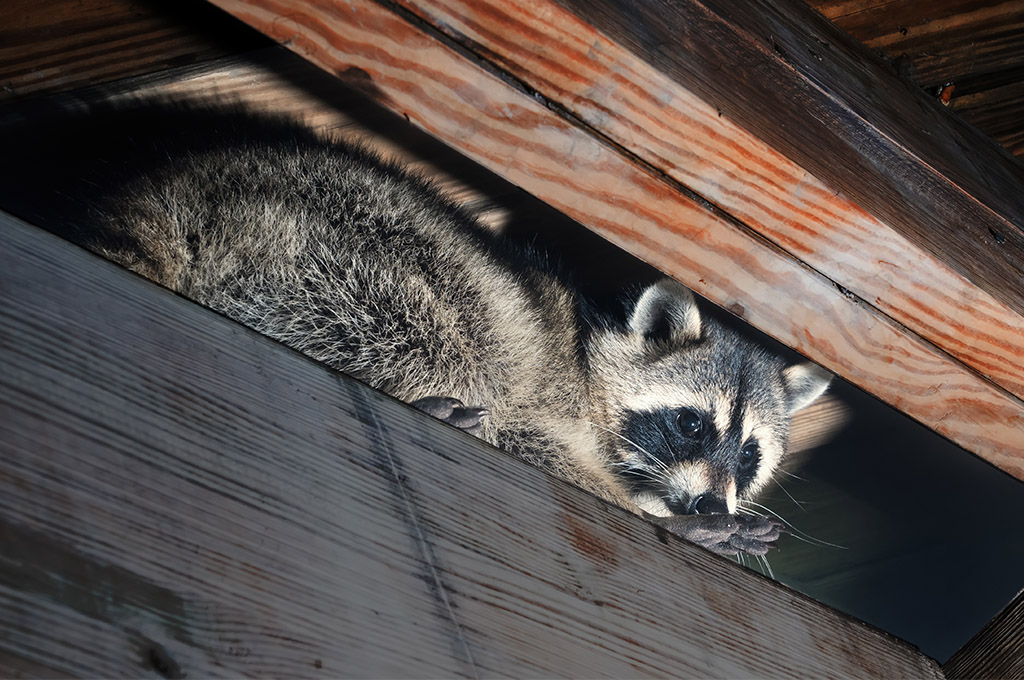
These woodland but increasingly urban creatures are related to the panda bear. They may look cute and cuddly with their bandit-mask eyes, luxuriant fur, ringed tails and tiny fingers, but raccoons are particularly destructive and can transmit serious diseases to both humans and pets.
They have the physical strength and dexterity to rip the shingles right off your roof or to pry up the soffit and fascia in order to get into your attic. Usually, they’re seeking warm, safe shelter to birth their young. Mother raccoons are territorial and fiercely protective.
Their entry points can leave gaping holes for rain and snow to penetrate, potentially causing serious water damage, leaks and mold growth. Inside their new lair, raccoons can damage insulation and wires by chewing on them, raising the risk of fire.
People usually associate raccoons with rabies. Although this is an extremely dangerous disease, it’s less common than many others they can cause. Rabies is caused by a virus spread through the raccoon’s saliva. If you or your pet is bitten by a raccoon, seek medical attention immediately.
Never approach a raccoon that appears to be ill, froths at the mouth or exhibits violent or strange behavior. The latter may include stumbling as though drunk or attacking inanimate objects.
- Squirrels.
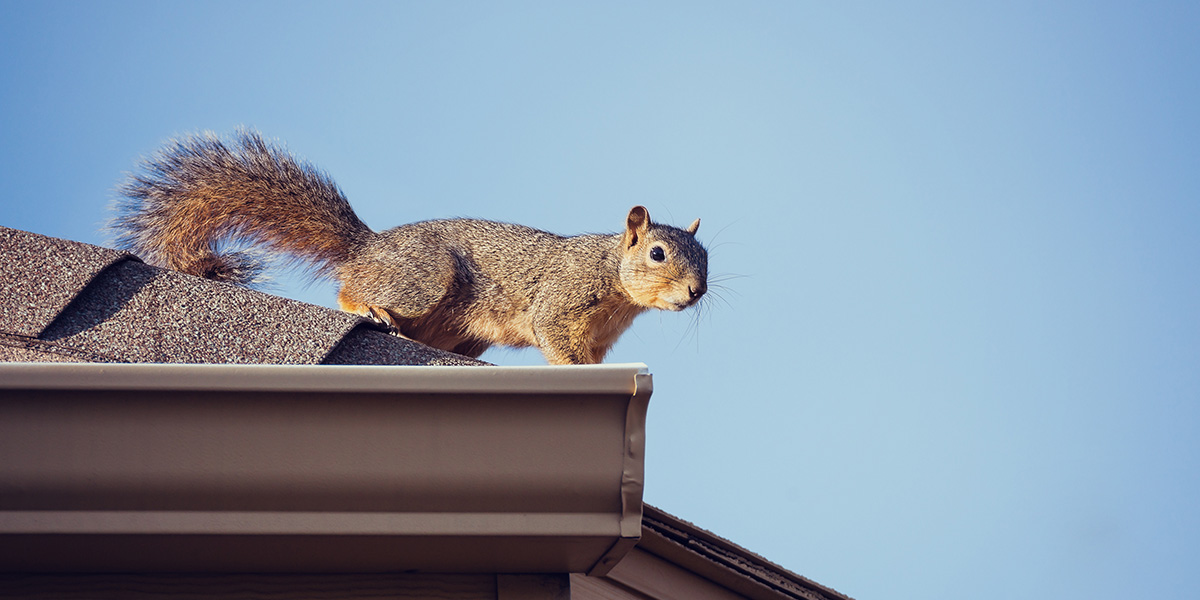
Squirrels are very entertaining to watch, as long as they stay outdoors. You don’t want them inside your home. In the fall, they will travel up to 50 miles in search of a suitably warm habitat. Squirrels can gain entry through the same access points as raccoons, only much more easily because they’re not as large.
They can run across power lines or land on your roof by launching themselves through the air from a nearby tree or neighboring roof. Once inside, these destructive rodents build nests by using their teeth and strong claws to gnaw through wires and PVC pipes, to chip up exposed wood and to rip up insulation.
A squirrel will rarely get close enough to bite, unless you or your pet corners one, the animal feels threatened or it’s trying to protect its young. Apart from the physical damage these members of the rodent family can cause, they can also transmit serious illnesses to both humans and pets.
- Bats and birds.

It’s not uncommon to have a bat or bird flying around inside the main living spaces of your home. In the summer, birds can easily enter the home through a patio door or window that’s been left open. Once you’ve shooed it back outside, check your attic. It’s unlikely, but possible, that others may be nesting there. If you have a bird inside your home when windows and doors are tightly shut, the chances are greater of having a problem in the attic.
On the other hand, if there’s a bat flying or perching upside down inside your living quarters, it’s a sign that there may be a whole colony of them in your attic. They love dry, secluded spaces where they can safely shelter from predators.
If you see a bat colony in your attic, deal with it immediately because bat colonies – and their guano deposits – can grow very large very fast. Bat droppings create an extremely offensive odor. They are also so acidic and highly corrosive, they can eat through building materials, destroying wood and rendering attic insulation less effective.
Bats can access your attic through a dime-sized opening, making your home extremely vulnerable to their infestation. Once they, and their guano deposits, have been removed, the entire attic must be thoroughly cleaned and disinfected, then any compromised building materials must be repaired or replaced. It’s not unusual for bats to carry the rabies virus. If you or your pet have been bitten, seek medical attention immediately.
Pigeons and starlings are among the most common bird species that typically enter and roost in your home. Starlings like to nest inside stove pipes and bathroom exhaust vents, whose heat acts as an incubator for their nestlings. In addition to making a lot of noise and creating unpleasant odors, starlings and their droppings can attract and cause infestations of insects, including cockroaches.
Pigeons are much larger than starlings and can carry several very serious diseases in from the wild; one of the most serious is meningitis. Adequate protective gear must be worn when removing the birds, including face masks. This is one more reason why you should hire a professional and not attempt to do this yourself.
Bird droppings on the roof create a slippery surface. Not only that, these droppings are so highly acidic, they can damage asphalt shingles and compromise their integrity. They may also provide nutrients that encourage the growth of algae or moss. Nesting materials are a hazard too. They can be dirty and infested with insects, or they can clog exhaust vents, raising the risk of fire. In rain gutters, nests can block water flow and cause it to back up and potentially infiltrate the roof under the shingles.
Read IKO’s advice to professional roofers about birds.
- Rats and mice.
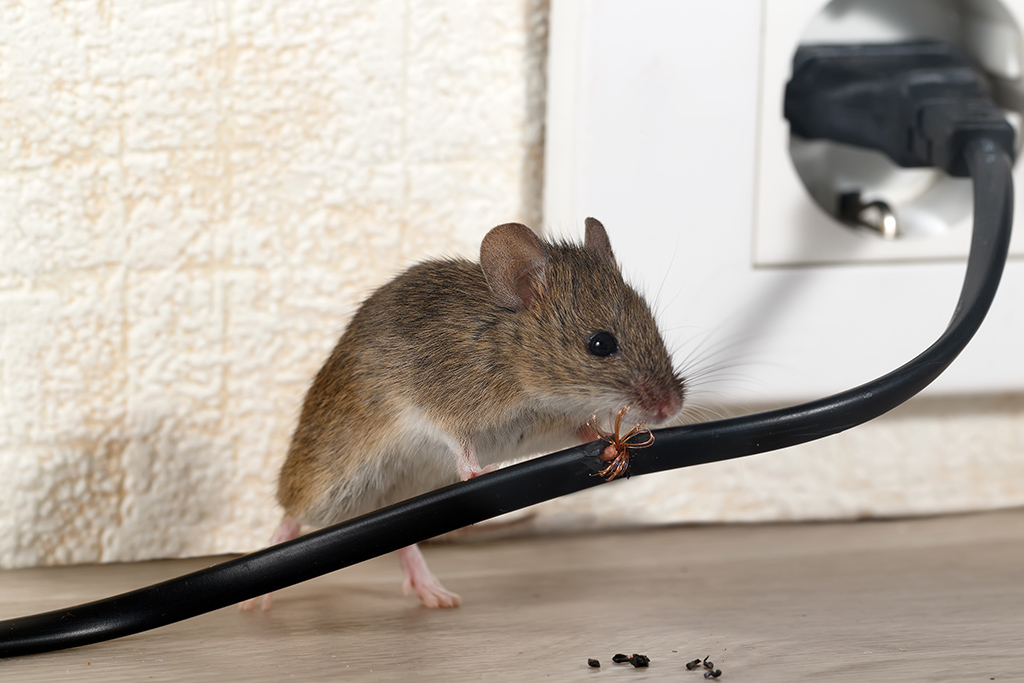
Rats and mice are among the most common pests to invade a home. It’s often thought that they’re attracted to garbage and clutter, but the truth is that these pests don’t care how dirty or how pristine and clean your home is as long as it can provide them with safe, warm shelter and a food source. They are most likely to come indoors in the fall, especially in wintry climates.
If you find droppings or see just one rat or mouse, you can be fairly certain there will be more because they reproduce very quickly and in quantity. A single mouse can excrete 70 fecal pellets a day. Over a year, that can add up to 25,000 droppings from just one mouse!
Mice often enter a home from ground level, and they can squeak through a crack no more than a quarter inch wide. Once inside, they can travel up walls between the studs throughout the home and into the attic. Rats may appear large, but they can enter through holes the size of a quarter.
Rodents are dangerous because they can gnaw through wood, wires, PVC pipes, insulation – even concrete – damaging your property and creating a fire hazard. Rats and mice can also be vectors for many diseases that can affect humans and pets either directly through their feces, urine or saliva or indirectly, through fleas, ticks or mites that have fed on an infected rodent, dead or alive.
- Wasps and bees.
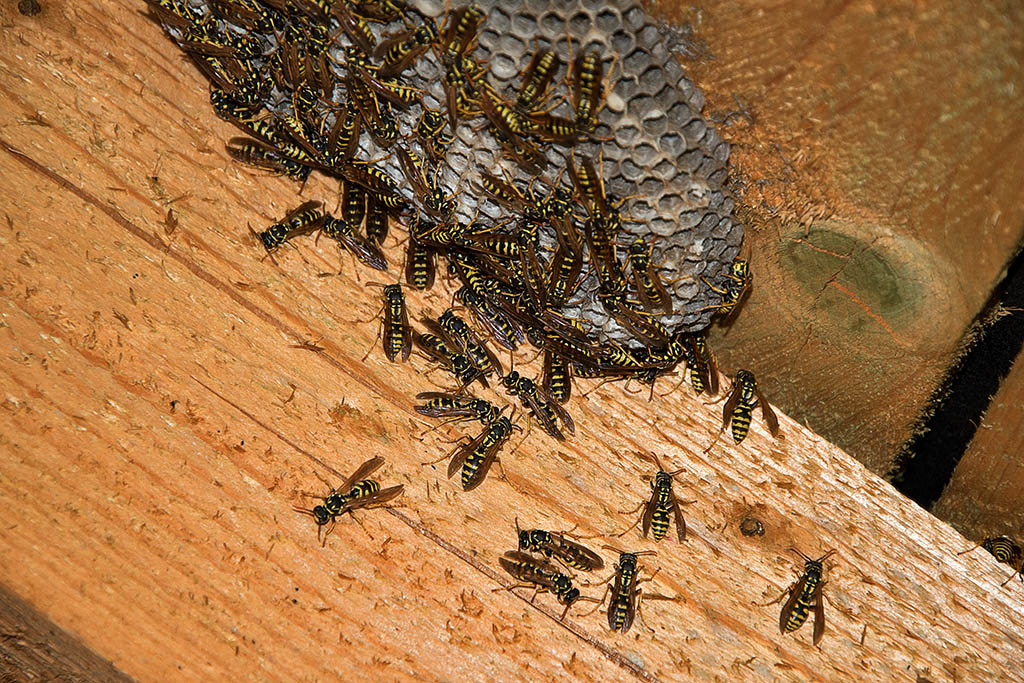
Hornets, wasps and bees are the tiniest tenants that might take up residence in your attic. It’s interesting to note that honeybees will not because the summer heat in an attic can reach 180 degrees Fahrenheit. The smart little honeybees seem to know that the wax in their hives will melt at 130 degrees Fahrenheit and cause their hives to slide down, so they choose to make their nests in the cooler shade of your eaves!
Flying insects like the quiet, inactive nature of the attic where they can nest and go about their business undetected and in peace. The greatest danger they pose is that they will bite or sting their human hosts.
If you do find a hive on your home’s exterior or worse, inside the attic, it’s best to have it removed and reduce the risk, especially if someone in your family is allergic.
Your family’s physical health is the most important reason that all pest problems be dealt with immediately and professionally, although protecting your property against potential fire and other damage is also important.
Once the offending creatures are removed from your home, measures must be taken to prevent further incidents. Let’s discuss some of them. Consult a wildlife removal professional for other ideas.
4. How Can I Prevent Animal Problems?
An ounce of prevention is worth a pound of cure, as the saying goes. It’s much easier and more cost-effective to prevent animals from getting into your home than it is to have them removed once there.
Here are a few things you can do to keep critters outside your home where they belong. Start by closely inspecting your home from the ground up:
- Seal any holes or cracks that could be potential entry points, whether at ground or roof level. Remember that mice can enter through the tiniest openings.
- Use steel to seal because rodents can gnaw through almost anything, even concrete, but they can’t chew through metal.
- Replace any missing shingles and repair any holes in the soffit or fascia.
- Cover downspouts and use gutter guards to help keep squirrels from entering.
- Install metal mesh or screening over large openings such as chimneys or gable or ridge vents.
- Remove climbing vines. They may look pretty on your exterior walls, but they are superhighways for mice to travel up to your roof and possibly access your attic. Note that their roots and tendrils can also damage masonry, brick work and other facings.
- Trim any branches or shrubs so they are at least six to eight feet away from your roof.
- Shield any electrical wires or phone lines that are nearby or entering your home because squirrels can easily run along them and jump onto your roof. A plastic wire/cable organizer will create a slippery surface that they can’t scamper across.
- Prevent raccoons from climbing up decorative trellises or wrought iron columns to reach the roof by attaching plastic around the column. A slide-a-boggan (rolled-up plastic snow slide) naturally curls up and around such structures and works well to thwart the animal’s ascent.
- Install plastic spikes along the eaves to deter starlings, pigeons and other birds from roosting there and leaving their corrosive droppings. Owl decoys and windsocks can also be deterrents.
- If you see an insect hive under your eaves, remove it as soon as possible. This is much easier and less dangerous to do at night, when the hive isn’t active.
- Scatter mothballs in your attic space to deter squirrels and rodents but be aware that the smell of naphthalene is unpleasant to humans as well and may be a health problem for some, as well as for pets. If using mothballs, you’ll need to replenish them frequently and be sure that pets and humans are not exposed to them.
- Check out other commercially available repellants but understand that they’re specific to the animal and may have undesirable human side effects.
- Opt for a natural repellant but realize they’re species-specific. Cayenne pepper solutions that work against garden pests like slugs and skunks, may or may not work on attic invaders. Birds, for example, are not deterred by cayenne because their olfactory sense doesn’t recognize or detect it.
5.What are Some Ways to Get Rid of Animals in the Attic Once They’re There?
As mentioned above, there are plenty of good reasons to have a professional remove any kind of animal from your attic or vents; but, if you feel you can safely manage it yourself, here are a few tips.
- Remember to wear protective gear, including heavy gloves and a face mask.
- Determine the animal’s point of entry and be sure to seal or block it once the animal has exited or been removed. You can also install a one-way trap so that once an animal leaves the attic, it cannot get back in again.
- Live trapping is the most humane and effective way to remove animals; however, it’s almost impossible for a homeowner to successfully remove a large infestation of rodents or bats. As soon as you’re aware of any animal present, act quickly to remove it before its population grows. Your area may regulate and require a license for trapping wildlife. Please check your area’s applicable laws.
- Check your local laws. Many communities throughout North America have strict laws against removing or even touching bird nests, for example. Even squirrels are considered to be protected species in some areas.
- If you have trapped and caught an animal, release it far enough away from your home that it’s unlikely to find its way back; however, be aware of wildlife laws that may limit the distance.
- Never corner a racoon. Mothers can be especially bold and vicious. If possible, wait until she has left her nest in search of food outside, then carefully move the nest of young racoons outdoors. She will tirelessly search for them; in the meantime, you can close up her point of entry. Always remove any feces and thoroughly disinfect the attic.
- If you have the confidence, you can try to remove a racoon with a long pole like a weeding implement that has a group of tines on one end that you can twist into the animal’s fur. The racoon will have no choice but to go wherever you lead it, preferably into a cage or live trap.
- Do not poison any animal. While you may be tempted to use warfarin on rats and mice, rodents cause problems dead or alive. Decomposing animals in your attic or walls not only create extremely unpleasant odors, they risk causing serious illness. Also, certain species of wildlife may be protected by law, limiting your ability to kill them.
6. Does My Home Insurance Cover Wildlife Incidents?
This is a harder question to answer than many homeowners think. It’s an important one to discuss with your insurance broker.
In general, a standard home or mobile home insurance policy will cover damage to your home that’s caused by a wild animal. Raccoons, opossums, skunks, birds and bats are considered wild animals, but take note that rats and mice are not. They are rodents, and the damage they cause is typically not covered by insurance. Insect damage resulting from bees, wasps, termites and roaches may or may not be covered.
Also be aware that the damage must have occurred in one single, well-identified event in order to be covered, not over a time period when you could have taken some preventive action but did not.
Most standard home insurance policies will cover damage and loss from fire that occurs in a single, identifiable event; but always check with your insurance professional to be sure.
7. What Does It Cost to Have Animals Removed?
It’s impossible to provide an estimate in this article. There are too many variables, including the type of animal, the service’s practices, how advanced the infestation is, etc. We hope this article has shown you what the potential cost might be in terms of property damage and your family’s physical well-being, if you do NOT have these animals removed.
We strongly recommend that you hire a professional to deal with any animal or pest problem in a safe, legal and humane way.
If you decide to inspect your home for possible entry points, always take proper safety precautions when using a ladder, for example.
Roofing professionals and animal removal experts often collaborate. Ask an IKO contractor to recommend a qualified service that provides humane animal removal in your area.

